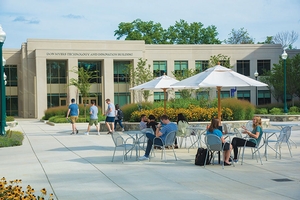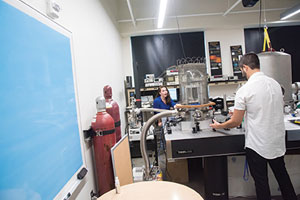Buildings
Don Myers Technology and Innovation Building Opens New science and technology building is built for collaboration

This fall, AU physicists, mathematicians, computer scientists, and game developers got a brand new home: the Don Myers Technology and Innovation Building, which features 70,000 square feet of high-tech laboratories, classrooms, and shared research space. Its state-of-the-art facilities on the East Campus offer students and faculty exciting new opportunities for collaborative and cross-disciplinary research.
"It's an exciting time for the sciences at American University," says Peter Starr, dean of the College of Arts and Sciences. "Twenty-first-century research requires twenty-first-century facilities. The Don Myers Building will build on the already vibrant synergy in the sciences here at AU and foster strong collaboration across the physical and mathematical sciences."
The building is home to the departments of physics, mathematics and statistics, and computer science, as well as the AU Game Lab, the Kogod Center for Innovation, and a makerspace known as the STEAM Works (science, technology, "entrepreneurship," arts, and mathematics).
The opening comes at a critical time. At AU, science is the fastest growing area of undergraduate study, and external grant funding for scientific research has increased 81.4 percent over the past seven years. As the university looks to the future, it is launching an initiative to raise $40 million to construct a second science building with cutting-edge facilities for biology, chemistry, neuroscience, and environmental science.

Students work in the new state-of-the-art LIGO laboratory.
